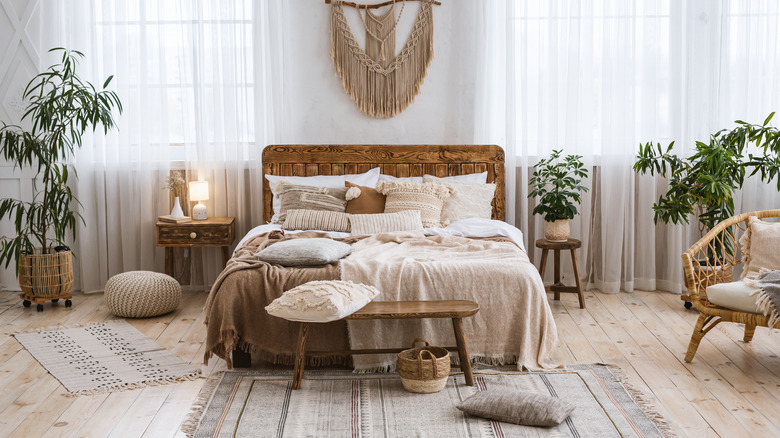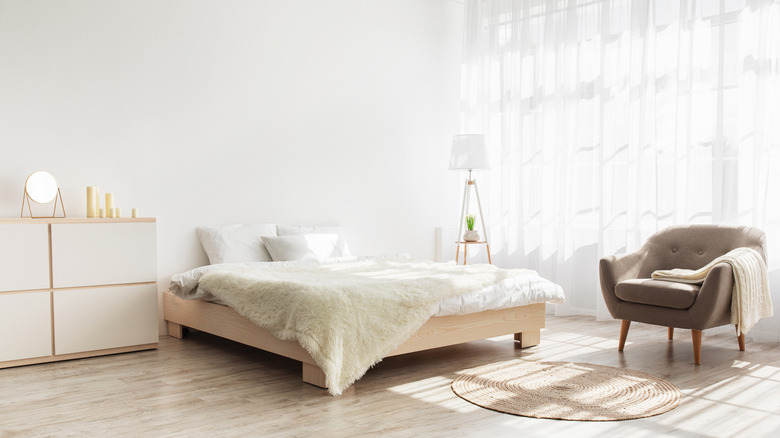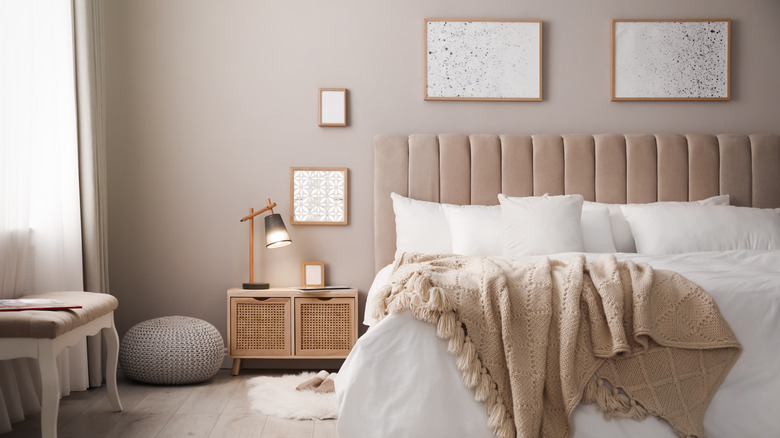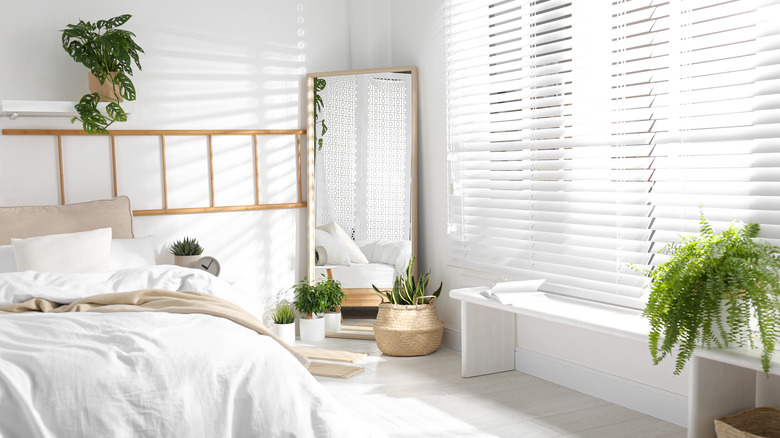A Design Expert Explains How To Decorate Your Bedroom For Maximum Relaxation
No matter what aesthetic you prefer in the rest of your home, you'll want to be conscious of the design choices you make in your bedroom. Even if you favor bright, bold choices in the other areas, they may not necessarily be the best fit for your bedroom. This is because, whether you're conscious of it or not, design choices affect how you feel in a particular space. "Your bedroom should cultivate a tranquil atmosphere as a sanctuary of serenity," explains Kelly Simpson, Senior Director of Design and Innovation at Budget Blinds. "You can easily create a calming and soothing space with color, lighting, and the right window treatment."
Now, this isn't to say that you must completely forego your preferred aesthetic to create a restful bedroom. Whether you love ornate vintage pieces or furniture with sleek modern lines, you can absolutely incorporate the items you truly love in your space. However, you should also keep a few general rules of thumb in mind. Even slightly tweaking the selections you make with relaxation as a goal can help create a bedroom that is both chic and calming.
In an exclusive interview with House Digest, Kelly Simpson shared her tips on the design decisions you can make in order to create a serene sanctuary where you'll be able to start and finish every day in style.
Choose a mellow color palette
Color has a huge impact on the ambiance of a room, whether it's the shade splashed on the walls or the hue incorporated throughout your accessories and furniture. When crafting a tranquil bedroom, assessing your color palette is one of the most important steps. "One of the best ways to achieve a calm and relaxing bedroom is by using light colors for walls, window treatments, and bedding," advises Simpson. "Lighter colors reflect more light, which can make spaces appear brighter and larger, promoting a sense of relaxation and spaciousness."
Those who prefer more muted tones in their space may have zero issues with this tip, but if you adore incorporating color throughout your space, you don't need to resign yourself to what you perceive as a boring beige and cream color palette — there are slightly more vibrant options within the shades Simpson recommends. "The best colors for the bedroom are light blues, soft greens, pale pinks, white, and beige, as some studies have shown that these colors can lower the heart rate and blood pressure, leading to reduced stress and anxiety," explains Simpson.
If you are constantly drawn to more saturated, bold hues, consider selecting a few paint sample strips with colors you adore. Then, see if any of the more muted options on that same sample appeal to you — chances are they'll share certain characteristics with the more intense shades that caught your eye.
Control your lighting to help create the perfect ambiance
Lighting does far more than just illuminate your home — it can be an absolute game changer when creating a particular atmosphere. For many rooms, you'll need to layer lighting to fulfill all your needs, sprinkling in softer, ambient choices in spaces where you just need some gentle illumination and more intense, focused options for spots where task lighting is needed, such as above your kitchen countertops. When it comes to your bedroom, though, you want to be extra careful about which types of lighting you incorporate. "Avoid harsh bright lights in the bedroom, which can be overstimulating," warns Simpson. "Instead opt for soft warm lighting, and use dimmer switches on ambient lighting (your primary light source)."
Simpson's recommendation isn't suggesting that you ignore your lighting needs — there may be certain spots, such as a little nook you use for reading or crafting or your bedside table, where you need a bit more focused illumination. "Use task lighting for activities where focused light is needed, such as reading, to help create a cozy and relaxing vibe," she advocates. Even in those areas, you can make certain tweaks to promote an overall feeling of relaxation in your bedroom, such as using a lightbulb that emits a warm white glow rather than a very industrial, bright white light or selecting fixtures that have a cover of some sort rather than an exposed bulb.
Darken the room for ultimate relaxation
It's essential to be mindful of all the light fixtures in your bedroom, from the primary overhead light to the accent and task lighting sprinkled throughout. However, you must also deal with the light coming through your windows. Natural light isn't always needed — there are times sunlight will pour in when you're still trying to sleep, for example. Or depending on the location of your bedroom, you may be dealing with various exterior lights that shine through your windows at night.
The solution is window coverings. "Room darkening window treatments should always be used in bedrooms to create a placid and restful environment," recommends Simpson. "Room darkening roller shades, cellular shades, roman shades, and drapery can block out most sunlight and streetlights, creating a dark environment and promote healthy sleep." This means that your window coverings must be functional and fashionable. If you've fallen in love with semi-sheer, gauzy drapery, for example, you may want to supplement them with blinds or shades that can block out the light when needed.
And, if the idea of constantly opening and closing your window coverings throughout the day sounds like a lot of work, you may want to seek out some of the more high-tech options available on the market. "These window treatments can even be automated and programmed to open and close at specific times throughout the day for effortless comfort and light control," explains Simpson.



